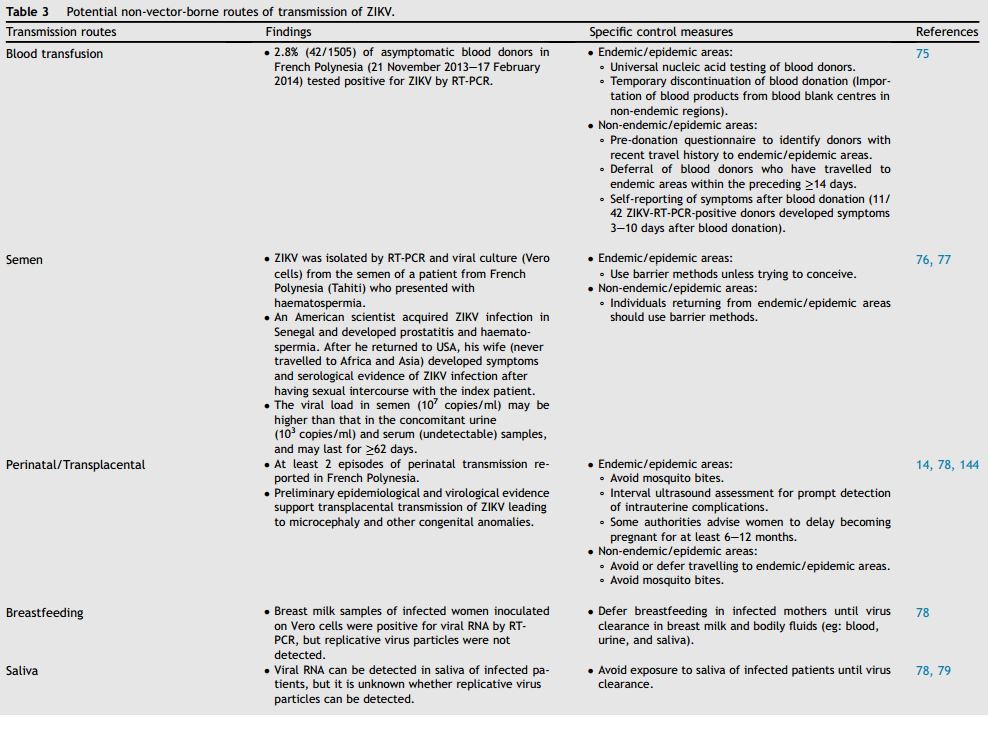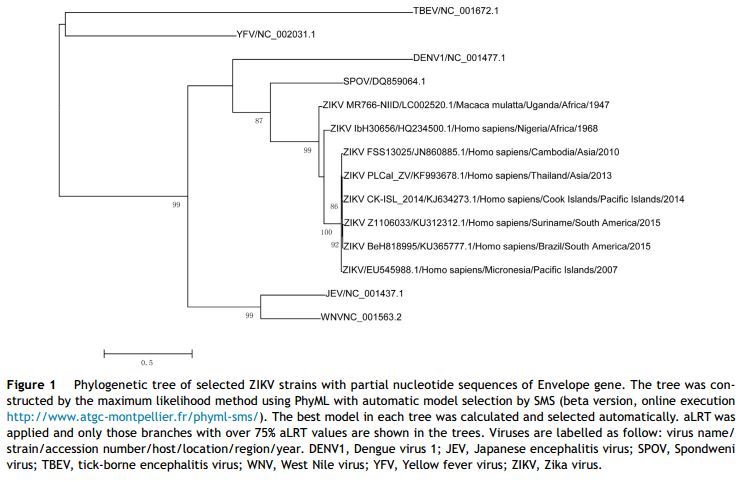All items in category Virus 1422 items
Table of contents
- All items in category Virus
1422 items
- Initial Description of the Presumed Congenital Zika Syndrome - April 2016
- Report on April 2016 study
- Zika fever and congenital Zika syndrome: An unexpected emerging arboviral disease - May 2016
Initial Description of the Presumed Congenital Zika Syndrome - April 2016
American Journal of Public Health: April 2016, Vol. 106, No. 4, pp. 598-600.
doi: 10.2105/AJPH.2016.303115
Demócrito de Barros Miranda-Filho demofilho at gmail.com, Celina Maria Turchi Martelli, Ricardo Arraes de Alencar Ximenes, Thalia Velho Barreto Araújo, Maria Angela Wanderley Rocha, Regina Coeli Ferreira Ramos, Rafael Dhalia, Rafael Freitas de Oliveira França, Ernesto Torres de Azevedo Marques Júnior, and Laura Cunha Rodrigues.
Accepted on: Feb 3, 2016
Objectives. To provide an initial description of the congenital syndrome presumably associated with infection by Zika virus compared with other syndromes including congenital infections of established etiologies.
Methods. We provide an overview of a published case series of 35 cases, a clinical series of 104 cases, and published and unpublished reports of clinical and laboratory findings describing cases diagnosed since the beginning of the epidemic of microcephaly in Brazil.
Results. About 60% to 70% of mothers report rash during pregnancy; mainly in the first trimester.
Principal features are
- microcephaly,
- facial disproportionality,
- cutis girata,
- hypertonia/spasticity,
- hyperreflexia, and irritability;
- abnormal neuroimages include calcifications, ventriculomegaly, and lissencephaly.
- Hearing and visual abnormalities may be present.
Conclusions. Preliminary data suggest that severe congenital abnormalities are linked to Zika virus infection. Cases have severe abnormalities, and although sharing many characteristics with congenital abnormalities associated with other viral infections, abnormalities presumably linked to the Zika virus may have distinguishing characteristics. These severe neurologic abnormalities may result in marked mental retardation and motor disabilities for many surviving offspring.
Policy Implications. Affected nations need to prepare to provide complex and costly multidisciplinary care that children diagnosed with this new congenital syndrome will require.
Publisher wants $22 for the PDF
Report on April 2016 study
- Congenital Zika Syndrome - Virology Blog
fetal abnormalities were detected in 12 of the 42 Zika virus positive women (29%)
none of the Zika virus negative women.
"The infections of these pregnant women with Zika virus took place throughout pregnancy, from week 8 to week 35. This window of susceptibility is in contrast to rubella virus which is more likely to cause birth defects when infection occurs in the first trimester"
"Not only do rubella and Zika viruses cause similar fetal and placental abnormalities, in the mother they both lead to rash, joint pain, skin itching, and lymphadenopathy without high fever."
"Hopefully the similarities between rubella virus and Zika virus will stop there: it took nearly 30 years to develop a rubella virus vaccine after the discovery that infection caused birth defects."
Zika fever and congenital Zika syndrome: An unexpected emerging arboviral disease - May 2016
Journal of Infection May 2016Volume 72, Issue 5, Pages 507–524, DOI: http://dx.doi.org/10.1016/j.jinf.2016.02.011 |
Jasper F.W. Chan, Garnet K.Y. Choi, Cyril C.Y. Yip, Vincent C.C. Cheng, Kwok-Yung Yuen
Highlights
•Zika virus (ZIKV) is an emerging mosquito-borne flavivirus.
•Probable transplacental and sexual transmissions of ZIKV have been reported.
•Congenital ZIKV infection may be associated with microcephaly and other anomalies.
•Laboratory diagnosis can be confounded by cross-reactivity with other flaviviruses.
•The expanding ZIKV epidemic may be related to environmental and viral changes.
Summary
Unlike its mosquito-borne relatives, such as dengue, West Nile, and Japanese encephalitis viruses, which can cause severe human diseases, Zika virus (ZIKV) has emerged from obscurity by its association with a suspected “congenital Zika syndrome”, while causing asymptomatic or mild exanthematous febrile infections which are dengue- or rubella-like in infected individuals. Despite having been discovered in Uganda for almost 60 years, <20 human cases were reported before 2007. The massive epidemics in the Pacific islands associated with the ZIKV Asian lineage in 2007 and 2013 were followed by explosive outbreaks in Latin America in 2015. Although increased mosquito breeding associated with the El Niño effect superimposed on global warming is suspected, genetic changes in its RNA virus genome may have led to better adaptation to mosquitoes, other animal reservoirs, and human. We reviewed the epidemiology, clinical manifestation, virology, pathogenesis, laboratory diagnosis, management, and prevention of this emerging infection. Laboratory diagnosis can be confounded by cross-reactivity with other circulating flaviviruses. Besides mosquito bite and transplacental transmission, the risk of other potential routes of transmission by transfusion, transplantation, sexual activity, breastfeeding, respiratory droplet, and animal bite is discussed. Epidemic control requires adequate clearance of mosquito breeding grounds, personal protection against mosquito bite, and hopefully a safe and effective vaccine.
Download the PDF from VitaminDWiki





Congenital Zika Syndrome (more than microcephaly) – Spring 2016
4377 visitors, last modified 01 May, 2016,
Printer Friendly
Follow this page for updates
This page is in the following categories (# of items in each category)
Attached files
ID
Name
Uploaded
Size
Downloads
6627
ZIKV features - brain.jpg
admin 01 May, 2016
59.23 Kb
853
6626
ZIKV features.jpg
admin 01 May, 2016
182.13 Kb
978
6625
ZIKV tree.jpg
admin 01 May, 2016
67.75 Kb
976
6624
ZIKV transmission.jpg
admin 01 May, 2016
128.16 Kb
1088
6623
ZIKV vectors.jpg
admin 01 May, 2016
76.46 Kb
1275
6622
congenital Zika syndrome May 2016.pdf
admin 01 May, 2016
696.82 Kb
1183
Table of contents
- All items in category Virus
1422 items - Initial Description of the Presumed Congenital Zika Syndrome - April 2016
- Report on April 2016 study
- Zika fever and congenital Zika syndrome: An unexpected emerging arboviral disease - May 2016
Initial Description of the Presumed Congenital Zika Syndrome - April 2016
American Journal of Public Health: April 2016, Vol. 106, No. 4, pp. 598-600.
doi: 10.2105/AJPH.2016.303115
Demócrito de Barros Miranda-Filho demofilho at gmail.com, Celina Maria Turchi Martelli, Ricardo Arraes de Alencar Ximenes, Thalia Velho Barreto Araújo, Maria Angela Wanderley Rocha, Regina Coeli Ferreira Ramos, Rafael Dhalia, Rafael Freitas de Oliveira França, Ernesto Torres de Azevedo Marques Júnior, and Laura Cunha Rodrigues.
Accepted on: Feb 3, 2016Objectives. To provide an initial description of the congenital syndrome presumably associated with infection by Zika virus compared with other syndromes including congenital infections of established etiologies.
Methods. We provide an overview of a published case series of 35 cases, a clinical series of 104 cases, and published and unpublished reports of clinical and laboratory findings describing cases diagnosed since the beginning of the epidemic of microcephaly in Brazil.
Results. About 60% to 70% of mothers report rash during pregnancy; mainly in the first trimester.
Principal features are- microcephaly,
- facial disproportionality,
- cutis girata,
- hypertonia/spasticity,
- hyperreflexia, and irritability;
- abnormal neuroimages include calcifications, ventriculomegaly, and lissencephaly.
- Hearing and visual abnormalities may be present.
Conclusions. Preliminary data suggest that severe congenital abnormalities are linked to Zika virus infection. Cases have severe abnormalities, and although sharing many characteristics with congenital abnormalities associated with other viral infections, abnormalities presumably linked to the Zika virus may have distinguishing characteristics. These severe neurologic abnormalities may result in marked mental retardation and motor disabilities for many surviving offspring.
Policy Implications. Affected nations need to prepare to provide complex and costly multidisciplinary care that children diagnosed with this new congenital syndrome will require.
Publisher wants $22 for the PDF
Report on April 2016 study
- Congenital Zika Syndrome - Virology Blog
fetal abnormalities were detected in 12 of the 42 Zika virus positive women (29%)
none of the Zika virus negative women.
"The infections of these pregnant women with Zika virus took place throughout pregnancy, from week 8 to week 35. This window of susceptibility is in contrast to rubella virus which is more likely to cause birth defects when infection occurs in the first trimester"
"Not only do rubella and Zika viruses cause similar fetal and placental abnormalities, in the mother they both lead to rash, joint pain, skin itching, and lymphadenopathy without high fever."
"Hopefully the similarities between rubella virus and Zika virus will stop there: it took nearly 30 years to develop a rubella virus vaccine after the discovery that infection caused birth defects."
Zika fever and congenital Zika syndrome: An unexpected emerging arboviral disease - May 2016
Journal of Infection May 2016Volume 72, Issue 5, Pages 507–524, DOI: http://dx.doi.org/10.1016/j.jinf.2016.02.011 |
Jasper F.W. Chan, Garnet K.Y. Choi, Cyril C.Y. Yip, Vincent C.C. Cheng, Kwok-Yung YuenHighlights
•Zika virus (ZIKV) is an emerging mosquito-borne flavivirus.
•Probable transplacental and sexual transmissions of ZIKV have been reported.
•Congenital ZIKV infection may be associated with microcephaly and other anomalies.
•Laboratory diagnosis can be confounded by cross-reactivity with other flaviviruses.
•The expanding ZIKV epidemic may be related to environmental and viral changes.Summary
Unlike its mosquito-borne relatives, such as dengue, West Nile, and Japanese encephalitis viruses, which can cause severe human diseases, Zika virus (ZIKV) has emerged from obscurity by its association with a suspected “congenital Zika syndrome”, while causing asymptomatic or mild exanthematous febrile infections which are dengue- or rubella-like in infected individuals. Despite having been discovered in Uganda for almost 60 years, <20 human cases were reported before 2007. The massive epidemics in the Pacific islands associated with the ZIKV Asian lineage in 2007 and 2013 were followed by explosive outbreaks in Latin America in 2015. Although increased mosquito breeding associated with the El Niño effect superimposed on global warming is suspected, genetic changes in its RNA virus genome may have led to better adaptation to mosquitoes, other animal reservoirs, and human. We reviewed the epidemiology, clinical manifestation, virology, pathogenesis, laboratory diagnosis, management, and prevention of this emerging infection. Laboratory diagnosis can be confounded by cross-reactivity with other circulating flaviviruses. Besides mosquito bite and transplacental transmission, the risk of other potential routes of transmission by transfusion, transplantation, sexual activity, breastfeeding, respiratory droplet, and animal bite is discussed. Epidemic control requires adequate clearance of mosquito breeding grounds, personal protection against mosquito bite, and hopefully a safe and effective vaccine.Download the PDF from VitaminDWiki
Congenital Zika Syndrome (more than microcephaly) – Spring 2016Printer Friendly Follow this page for updates4377 visitors, last modified 01 May, 2016, This page is in the following categories (# of items in each category)Attached files
ID Name Uploaded Size Downloads 6627 ZIKV features - brain.jpg admin 01 May, 2016 59.23 Kb 853 6626 ZIKV features.jpg admin 01 May, 2016 182.13 Kb 978 6625 ZIKV tree.jpg admin 01 May, 2016 67.75 Kb 976 6624 ZIKV transmission.jpg admin 01 May, 2016 128.16 Kb 1088 6623 ZIKV vectors.jpg admin 01 May, 2016 76.46 Kb 1275 6622 congenital Zika syndrome May 2016.pdf admin 01 May, 2016 696.82 Kb 1183